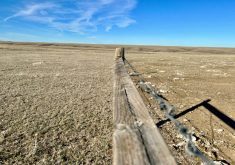No Prairie farmer worth his or her salt would admit to not being good at growing wheat.
Farmers have been growing wheat in these parts for more than 200 years and they’ve earned quite a reputation for themselves selling it to the world.
But a former senior federal research scientist with Agriculture and Agri-Food Canada hinted at a recent Canadian Global Crops Symposium that perhaps farmers here could be growing it better — with a little help.
In outlining his concerns with the current wheat research agenda, Stephen Morgan Jones noted wheat yields increase by about 1.3 per cent per year, half of which is due to genetics and half of which is due to improved agronomy.
Read Also

Foggy grain market predictions for 2026
Many factors are pushing and pulling at grain markets as farmers leave 2025 behind and start considering what 2026 will bring.
Yet when it comes to research, agronomy gets about 10 per cent of the total research funding.
Morgan Jones asked his audience to consider whether the 266 active public research projects investing about $45 million annually in improving the crop are hitting the mark. And while we’re at it, what is the mark?
“We talk about increasing wheat yield, but do we really have any idea of where we want to get to over the next 15 years?” he asked.
While the numbers would suggest Canada has a robust wheat development program, many of the projects are small and underfunded — especially in the area of improved agronomy.
He also pointed to the ongoing research into fusarium head blight. There are 30 projects dedicated to it, but after 25 years and millions of dollars invested, little progress has been made.
The three provincial wheat commissions were quick to respond. In a letter to the editor in our April 28 issue of the Manitoba Co-operator they cite several examples of where they are co-operating to better understand the wheat genome and improve wheat varieties available to farmers.
But even their response is focused on varietal development.
There’s no denying continuous varietal improvement is important to the future of any crop.
However, Plant Breeders Rights and other forms of intellectual property protection have made it easier for researchers to capture a return on investment from new varieties and crop protection products. There has been no way found — as yet — to do the same with techniques.
That relegates agronomic research to the purview of publicly funded researchers, provincial extension services — both of which are chronically underfunded — and projects paid for by producer checkoffs.
A seed that yields more for the same amount of inputs is an easy benchmark to target. Those incremental gains — the one per cent here, the five per cent there — that come from the combined efforts of thousands of farmers are not so easily measured or achieved.
When the Canola Council of Canada began looking into how to consistently increase production a few years ago, it soon became clear that the focus had to be on the ‘how’ of growing as well as better varieties.
In fact, four out of the five pillars in the council’s strategy to increase average yields from 34 bushels per acre to 52 by 2025 are about agronomy. Only eight bushels of the 18-bushel target gain comes from genetic improvements.
It’s fair to ask whether a similar approach is needed for wheat.
















